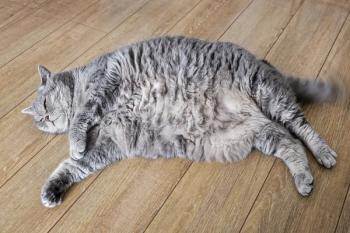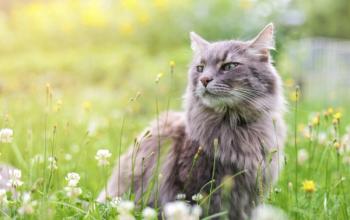
Flip your script to fix relationships with cats
Go beyond what meets the eye and see that your "fractious" and "frazzled" feline veterinary patients are actually trying to tell you something different with their body language.
Happy? Sad? Frisky? What do you think this cat is feeling? (Getty Images)Cats don't have an opinion about how you describe them. What matters to them is how this experience, in this moment, compares with similar remembered events. How we describe a cat's emotional state, however, does have a tremendous impact on the people around us. First, we need to be right about our interpretation of facial expression and body postures. Next, we need to accurately reflect cats' emotions to people who will be interacting with our patients. We need to use the words that are descriptive without imposing a negative interpretation.
Sticks and stones …
Words not only affect us temporarily-they change us. Attitudes are infectious and can affect people that are near a cat exhibiting a given attitude, which can, in turn, influence their behavior. For example, if a friend describes someone you've never met as bossy or domineering, when you meet that individual, your tone and body language may be quite different than if that person had been described to you in advance as charming and considerate. In the same way, our description of a cat's attitude will influence how support staff and other doctors will choose to interact with that patient.
Photos courtesy of Dr. Elizabeth Colleran
In recorded interviews conducted by Veterinary Medicine, the cat pictured above was described as “ticked off,” “mad,” “dangerous” and other similar but unprintable descriptors. In fact, this cat is terrified.
Fear is a response that enables avoidance of perceived danger. Anxiety results from the anticipation of an adverse event based on a previously negative, fearful or painful experience. Previous experiences in the veterinary setting can predispose patients to reacting fearfully from a remembered event or react fearfully to a change in circumstances.
Because the ears are very sensitive, a cat that is frightened will fold them back, presumably to protect them from anticipated harm. Because the words used to describe the cat to the right have very negative connotations, it is quite possible that this cat might have been handled more aggressively or roughly than it should have been. How we describe our patients can have a powerful impact on their experience with us. It is true that this cat's facial expression indicates that care must be taken when handling it, but not that it is a bad cat.
A cat with a past
We also must be careful to be correct in our interpretation of a feline patient's emotional state. When we ask support staff to interact closely with a patient, they need to know what to expect. That is often the function of our historical experience with a patient as well as our observation of behavior in the present moment.
While several people recognized the tense expression, dilated pupils, forward whiskers and intent gaze of the cat pictured above, this cat was also described by others as “comfortable,” “in a good spot” and “happy.”
If orders had been given for him to have blood samples drawn or radiographs or another form of therapy performed while using the latter descriptors, support staff members might have been very relaxed in their approach to him. That would have been a dangerous mistake. Historically, this patient needed to be sedated in order to be examined. After observing him entering the building in his owner's arms, we learned that we could interact safely with him-as long as she held him. Knowing our patients and recording our observations in neutral language can help ensure that we make a balanced yet informed plan for interacting with challenging patients.
A long history of clandestine behavior
Cats draw conclusions about the relative safety of an experience based on previous, similar experiences. A fearful cat will make itself look as small as possible by crouching and then slink away, or if the cat judges that running away may provoke a chase, it will make itself look as large as possible by arching and raising the fur on its back. The choice will be influenced by what happened the last time the cat was in similar circumstances. It is no wonder then that early veterinary experiences have powerful impact.
Cats still have three out of four feet firmly planted in their wild origins. They are undemonstrative; they keep feelings to themselves and rarely tell us what they need, beyond asking for food when they're hungry. Cats carry the legacy of their primal pasts, and much of their behavior still reflects their wildest instincts. To understand why a cat behaves a certain way under any circumstances, we must understand where they came from and the influences that have molded them into who they are today.
The way they experience the world around us is far different from the way we do. Armed with this knowledge, we can learn to interact with them in ways that reduce stress and minimize arousal. For a solitary, territorial, hunter suddenly removed from his home range and faced with a variety of strangers, new odors, loud noises and unwanted attention, it is no surprise that they react fearfully.
The more cats, not necessarily the merrier
Opinions differed on the cat pictured below. He was alternatively described as “happy,” “a little fearful,” “perturbed,” “relaxed” and “comfortable.” Knowing how cats sleep may help doctors and support staff recognize problems at home in situations where cats have not formed social groups. Just because two cats have the same owner does not mean they are going to get along. Owners often ignore the cardinal rule of cat society: Proceed with caution when meeting any cat that has not been part of your (cat) family for as long as you can remember.
Many cat owners, oblivious to this principle, blithely assume that when they obtain a second cat, the two will quickly become friends. One sign of social unrest and stress is seen in this cat: defensive sleep. While he is curled up, with his tail wrapped around his body, he seems rather relaxed. However, his ears are pointed forward and tense, and one eye is partially opened but not staring intently. He is actually in a boarding area that he has grown quite accustomed to. He was sleeping comfortably until he heard the door open. While he is aware of a change in his environment, he hasn't changed his body posture to prepare to flee or fight.
Similarly, cats that don't trust their cat housemates much may exhibit this type of sleep behavior and other problems related to household stress may develop. Counseling clients to provide ample resources including separate spaces to eat, sleep, rest, escape and eliminate is crucial for reducing stress in these homes. Understanding subtle behavior cues and how to interpret them is key.
Final thoughts
We need to describe cats' emotional states in terms that invite the appropriate attitude on the part of the entire team. Negative words in the interviews Veterinary Medicine held included “dangerous,” “mad,” “likely to attack,” “bad” and “ticked off.” These are words that can change attitudes from respectful to antagonistic. They can change behavior from appropriate caution and gentle restraint to forceful even painful choices.
Dr. Elizabeth Colleran is the owner and hospital director of two exclusively feline practices and is an ABVP Diplomate in feline practice. She participated in the 2013 Bayer Veterinary Care and Usage Study 3 – Feline Findings. Prior to veterinary school, she worked in Sales and Marketing Management for IBM where she worked with Fortune 500 companies to streamline internal networks. Her passions are her crazy husband, two equally crazy Burmese cats, bicycling and Indian cuisine.
Newsletter
From exam room tips to practice management insights, get trusted veterinary news delivered straight to your inbox—subscribe to dvm360.






